Speech at Policy Exchange, London
Financial stability in a European environment – a cross policy approach
Historisk arkiv
Publisert under: Regjeringen Solberg
Utgiver: Finansdepartementet
Tale/innlegg | Dato: 06.04.2018
– Building buffers in our financial system is the best way to make our economies less vulnerable to the consequences of financial disruptions, said Minister of Finance Siv Jensen (Progress Party) in her speech at Policy Exchange today.
Check against delivery
The financial crisis in Oslo in the late 1800s, the so-called Christiania crash, left deep scars. Not only among ordinary people who saw their fortunes evaporate, but also in the city’s physical landscape.
Large parts of today’s city center in Oslo were built during the housing market frenzy of the 1890s. When the housing market collapsed in 1899, building activity came to a more or less complete standstill that lasted for years, leaving the architecture of the 1890s as one of the city’s distinctive characteristics.
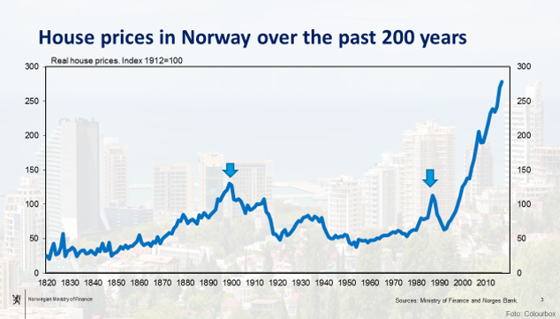
It took 90-years for house prices, in real terms, to recover most of their losses. A new financial crisis was then approaching. In recent years, house prices have surged once again, fuelled in part by low interest rates at home and abroad.
The housing market is at the core of much of our work on financial stability. For obvious reasons, my speech will focus on our own initiatives, how we apply European rules and regulations, and use a combination of different instruments to promote financial stability.
Why housing is important
To own the house you live in is of great value to most Norwegians. Owning a house can give a sense of safety and security, especially in a country where the long winter season is predominantly wet, cold and dark. In Norway 80 percent of households own the house they live in and the majority of households’ assets are tied up in their home. The UK also has a relatively high homeownership rate of about 65 percent. Strong public interest in housing market developments illustrates the important role housing plays in the economy. Not a day goes by without the housing market being mentioned in the news.
Hence it is of great importance for us, as well as for many other countries, to have a well-functioning and efficient housing market, characterized by sensible regulation and reasonable construction costs.
The role of house prices and debt

Asset prices and debt tend to move hand in hand. Periods of rapid economic growth are often accompanied by exuberance on the part of firms, households, as well as the financial sector. The result is often a debt-financed investment boom and rising asset prices. When the cycle turns, we see the opposite: a sharp fall in asset prices, tighter lending conditions and potentially harsh downturns with high unemployment.
This basic insight is not new: In 1933, the American economist Irving Fisher used strong words when describing the relationship between debt accumulation, asset prices and economic cycles. He argued that asset price booms and high levels of debt were “economic maladies and the most important causes of severe economic downturns”. This was after he was hardly hit himself by the 1929 stock market crash. A sense of bitterness can be seen in his writing. He was at the time infamous for his claim, just prior the crash, that the stock market had reached a new permanently higher level.
Fisher went on to describe several episodes in the late 1800s that displayed the same pattern: recessions that follow periods of rapid debt accumulation and strong asset price inflation tend to be deep and long lasting.
The Norwegian banking crisis in the late 1980s, one of the worst financial crises in advanced economies in modern times according to Carmen Reinhart and Kenneth Rogoff, is an example of this. Real house prices declined by 40 percent and did not return to pre-crisis levels for more than 12 years, the number of unemployed tripled, and the three largest banks in the country collapsed.
Similarly, many European economies caught up in the global financial crisis have only recently returned to their pre-crisis GDP levels.
This taught us the value of good regulation and supervision of the financial sector, which has been an important policy objective for all Norwegian governments since the late 1980s.
In the past few years, many countries have once again experienced rapid growth in asset prices and an accumulation of debt that once again has raised concerns about a build-up of financial imbalances.
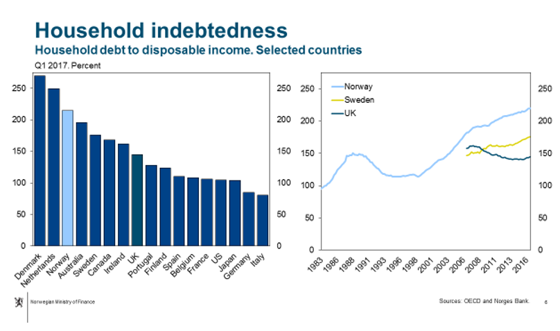
High household indebtedness is a severe risk to the economy. In Norway, households currently have an aggregate debt-to-disposable income ratio above 200 percent. This is one of the highest levels among OECD countries. While household indebtedness has fallen in many OECD countries in recent years, including in the UK, it has continued to increase in Norway. This makes households vulnerable to changes in income, interest rates, and house prices, that could result in an abrupt adjustment in consumption.
A comparison of debt levels across countries may of course be complicated by differences in the financial system and other institutional characteristics. Nevertheless, increasing indebtedness over time may suggest that downside risks are increasing.
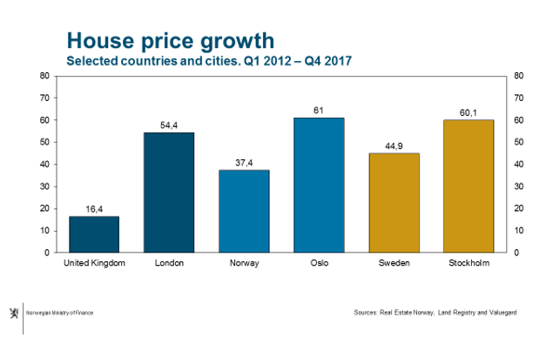
Several cities, including until recently London, have witnessed sharp increases in house prices in recent years. London, Stockholm and Oslo are shown in this graph, but cities like Toronto, Sidney and Berlin could be added to the list.
An extended period of low interest rates may be one reason for this pattern. There are studies that show that house prices are more sensitive to interest rate changes in places where land is relatively scarce, which usually is the case in cities. Strong investor appetite for urban properties in recent years, both commercial and housing, is an additional factor behind accelerating property prices in cities.
The rapid increase in house prices and debt has prompted authorities to take action. The package of policies taken differ across countries and I will come back to the measures we have introduced in Norway.
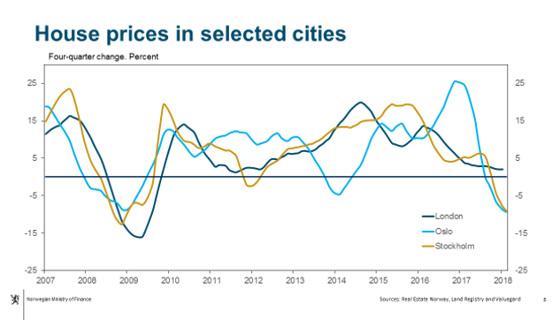
Recently several cities have seen a price correction. One common factor is that interest rates have either started to increase, or are soon expected to increase. However, local factors are also important. Here in London prices declined after the Brexit-referendum. In Stockholm, prices fell rapidly last autumn after strong growth in previous years. In Oslo, we have welcomed the gradual correction in house prices after years of strong growth.
The role of banks
Banks and other financial institutions have an important role to play in channelling funds from savers to those who want to borrow to buy a home.
Banks are profit maximizing institutions. It is well known that banks have incentives to take greater risk than socially desirable, and their behaviour can amplify upturns and downturns in the economy.
Incentive problems arise because an important group of creditors – the depositors – are not able to efficiently monitor the bank’s behaviour and because the price of deposits – the deposit rate – does not necessarily reflect the risk profile of the bank. At the same time, bank executives can earn large profits by investing depositors’ savings in high return high risk assets. This distortion may be amplified by deposit guarantees and expectations of government bailouts.
When banks get into trouble, it’s not only shareholders, creditors and depositors that are affected, but also the economy as a whole. First, banks can become less willing and less able to lend. This can make it harder for firms and households to finance their investments and cause a decline in economic activity. Second, because the financial sector is more closely integrated than ever before, problems in one bank can easily spread to other financial institutions and thus have implications for the financial system as a whole. Thirdly, there are many examples that bank collapses ends up in higher public expenditures due to “too big to fail” challenges.
For these reasons, it is in the public interest that financial institutions maintain sufficient financial buffers – on both sides of their balance sheet – to draw on in harsh times. Individual financial institutions have few incentives to take into account the risk they pose to the financial system as a whole and the economy more broadly. If financial institutions were free to choose these buffers themselves, they would probably choose smaller buffers than what is socially optimal and necessary in order to safeguard financial stability.
Why regulate
As a politician coming from a libertarian political tradition, I believe in freedom of choice and a limited government that empowers people and businesses to achieve their goals. I generally believe that the free market will find the best outcome, and I therefore prefer to avoid regulation whenever I can.
However, the knowledge that strong growth in house prices and debt can cause much harm to the economy, and also the important role of banks, implies that regulating the financial sector is necessary to safeguard financial stability and to ensure a safe housing market. As the minister of finance I also have to keep an eye on state expenditures, as it is often the Government that has to come in when big banks fail.
We need to strike a balance. We have to accept that there is a need to regulate the financial sector but we should never forget that the “art of banking” is better handled by bankers than by politicians.
What are policies promoting financial stability?
Promoting financial stability is different from many other areas of economic policymaking. While economic policy generally aims to achieve the best possible outcomes, like maximising welfare for its citizens, policies promoting financial stability are aimed at preventing the worst possible outcomes. Hence, these policy areas are by nature quite different. When we introduce policies to promote financial stability, our goal is to prevent crises from happening, and if they do happen, we want to make sure that the consequences for the economy are as small as possible.
Most areas of economic policy, like monetary policy, have a clear objective and well-defined tools. Financial sector policies, on the other hand, are aimed at a broad set of objectives that are difficult to evaluate ex-post, and the set of policies available consists of a diverse set of tools that influence the objective in different and indirect ways.

Regulating banks and financial institutions is the first line of defence against the build-up of risks in the financial sector. Policies that promote the resilience of the financial sector reduce the likelihood that the behaviour of individual financial institutions will have systemic implications and spill over to the real economy.
In recent years, macroprudential policies have become an important part of the toolkit. Macroprudential policy aims to address systemic risks, that is risks to the financial system as a whole. While prudential regulation traditionally has been oriented towards addressing institution specific risk, the financial crises made us more aware of risks that affect the entire system.
Examples of systemic risks include contagion risk that arise from strong linkages between banks, exposure concentration or risk related to the build-up of financial imbalances. Macroprudential policies to address systemic risks include additional capital requirements, liquidity requirements or restrictions on banks’ lending practices.
I will come back to our integrated approach to promoting financial stability later, but first I will take a few minutes to discuss the role of international financial market regulation.
International cooperation to promote financial stability
Today’s economic landscape is characterized by highly integrated financial markets, increasingly sophisticated financial institutions operating in several jurisdictions, and a rapidly changing global regulatory environment. When risks materialize, they can spread fast between institutions and countries.
There is always a risk that financial services will be provided from jurisdictions with weaker regulation. Harmonized financial regulation is beneficial for the efficiency and stability of our financial markets, allowing for well-functioning cross border operations.
More integrated financial markets, and in particular the international financial crisis in 2008, have led to an effort by the G-20, the Financial Stability Board and the IMF, to develop a set of common international standards and rules for the regulation and supervision of the financial sector. The Basel Committee on Banking Supervision has formalized these efforts into broadly accepted standards and guidelines.
The first set of common standards for banks – the first Basel Capital Accord - was introduced in 1988, and has since been supplemented by two accords – the Basel II and Basel III. Most advanced jurisdictions, for example the US and the EU, have transposed these standards into legislation.
I understand those who argue that international common standards for governing the financial sector have become too large and complex. The chief economist at the Bank of England, Andrew Haldane, made this point succinctly simply by counting the pages of the different vintages of the Basel accords. I am also well aware that some of the regulation that has emerged after the financial crisis resembles “old wine in new bottles”. More generally, we must not forget the reasons why we abandoned the intrusive regulatory environment of the 1950s and 60s and we must strive to avoid unnecessary regulation.
The global financial crisis demonstrates clearly, however, the need to impose sensible regulations on the financial sector. It is my firm belief that if Basel III is successfully implemented throughout the world, the global financial system will be better able to weather the next financial crisis. However, it is critical that we work together. When talking to industry representatives in Norway, a major concern is unlevel playing fields, differences in capital requirements between countries, and the scope for regulatory arbitrage.
Region-wide regulatory frameworks, like in the EU, ensure a good degree of harmonization of rules across countries. As a member of the European Economic Area, Norway has an obligation to implement most of the financial regulations adopted in the EU. The UK’s neighbouring countries, including Norway, have an interest in the UK continuing to implement the Basel accords and other important standards, also post-Brexit. And we have an interest in the UK continuing to endorse the idea of common rules and a level playing field.
Countries with highly integrated banking sectors may also benefit from cooperation among supervisors to get a common understanding of risks and regulatory needs. In the Nordic and Baltic region we have established meeting places and foras for discussion and cooperation, since several Nordic banks operate across the whole region. On the regulatory side, these foras make it possible to discuss local needs within a regional context and have in several instances resulted in voluntary reciprocity of prudential requirements within the region. On the supervisory side, we have agreements about information sharing.
The cooperation within the Nordic-Baltic region on bank supervision has served us well and facilitated the transition to a new regulatory regime after the financial crisis.
While the rest of Europe was deleveraging after the global financial crisis, household debt in Norway continued to rise. This both allowed and required Norwegian authorities to be proactive in addressing financial risks. At times we have chosen to implement the new regulations earlier than in the EU, and we have often used any available flexibility in the EU frameworks to tighten regulations further.
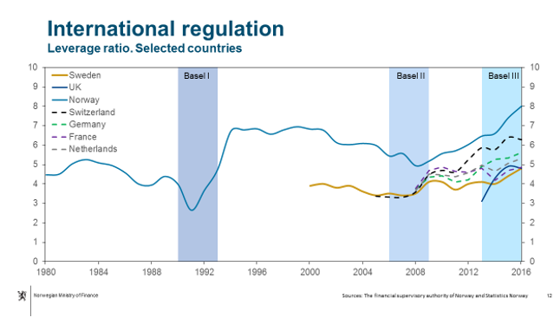
We have strongly promoted the build-up of own funds in the banking sector, and we can now see the results in international comparisons of leverage ratios. Norwegian banks are already fully compliant with Basel III requirements, while many other European banks still have a way to go.
Some parts of the financial market regulation has a macroprudential focus, and is more tailored to national needs and conditions. In particular, the use of macroprudential measures must acknowledge that countries may be at different stages of the financial cycle. At times it may even seem as if there is an inherent conflict between the notion of common international standards and macroprudential measures that are set at an individual country level.
We should continue along both paths – fighting loopholes in supervision and regulatory arbitrage, as well as emphasising host-country regulation and supervision.
Let me now address the measures taken in Norway to promote financial stability.
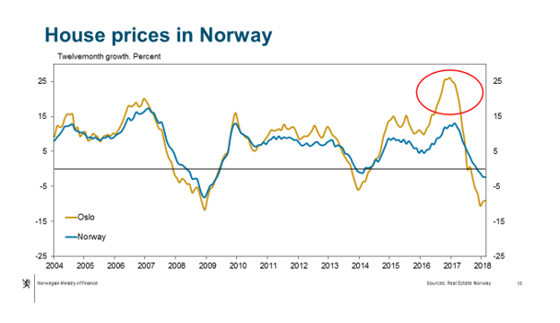
Up until a year ago, Norway experienced strong and accelerating growth in house prices. Household debt was – and still are - growing steadily faster than income. As a result we have found it necessary to take several measures to address this increasing vulnerability in the household sector and especially the housing market frenzy.
A simple rule of thumb could be that double-digit growth in housing prices should raise concern. After several years of brisk growth, house prices in Oslo approached an annual growth rate of 25 percent at the end of 2016. In such a situation, the warning lights should flash.
In addition to stricter requirements on liquidity and capital, including a countercyclical capital buffer of 2 per cent, we have introduced a regulation on mortgage lending.
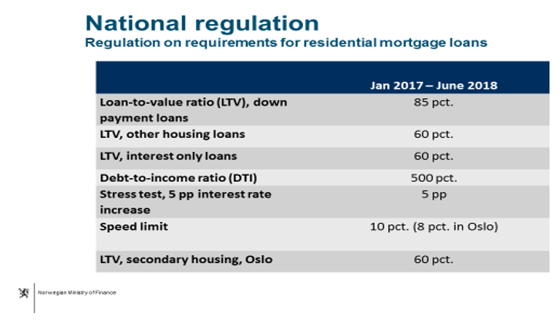
The aim of introducing this regulation first in 2015, and again in 2017 in a somewhat stricter form, was to contribute to a more sustainable residential mortgage market.
So far, the measures seem to have worked well. The share of new mortgages that are very large relative to income and house value, has been reduced. Also- housing prices have stopped growing and even declined moderately through 2017, as you might have noticed from the previous graph.
The regulation included a limit on the loan-to-value ratio of 85 percent, a maximum debt level of 5 times your gross annual income, and an amortization requirement on mortgages with a high loan-to-value ratio.
Banks have flexibility to provide loans that do not satisfy all requirements, a so-called “speed limit” of 10 percent. In Oslo, where house prices have risen considerably faster than in the rest of the country, we introduced a more restrictive limit on the loan-to-value ratio for secondary homes, and a lower speed limit.
The flexibility for banks to do a proper credit assessment was an important part of the regulation, and that is why we included the speed-limit. Other countries that have introduced mortgage lending requirements have also set a speed-limit, including the UK.
I believe this is where we depart from the regulatory doctrine of the post war period – we acknowledge the need for regulation, but we are cautious not to regulate banks so heavily that we effectively take over the responsibility for their business. Regulation should be crafted in a way that leaves banks with responsibility for running their businesses.
The current regulation expires in late June this year. We are in a process of evaluating its effects and the need to keep it in place. A public consultation is soon to be completed. In general, requirements that responds to transitory events should also be transitory. However, to keep some limitations on the size of mortgages, for example related to home value and income, may be sensible regardless of the state of the economy.
A cross policy perspective
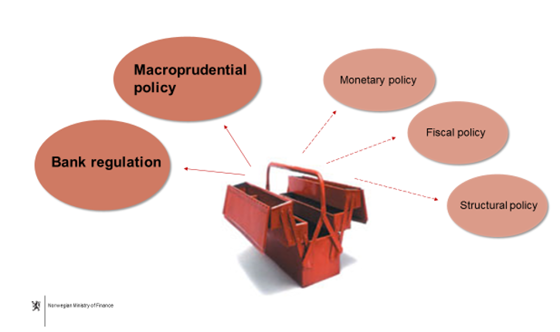
The traditional policy tools aimed at promoting financial stability are mostly geared toward building capital and liquidity buffers in banks, households, and firms. Their ability to address the underlying accumulation of risks, however, is less clear.
We have ample evidence that a more solid capital base makes banks less vulnerable to negative shocks, but we have little evidence that higher capital requirements are effective at preventing the build-up of financial imbalances. Similarly, requirements on mortgage lending can reduce the number of vulnerable households, but their effect on overall debt accumulation is less clear.
A cross policy-approach is therefore warranted. Fiscal policy, monetary policy, structural policy and financial market regulation need to work together to deliver a stable financial system that can contribute to societies broader economic and social objectives.
Both monetary policy and fiscal policy have important roles to play in counteracting the build-up of financial imbalances.
Contractionary macro policies during an upturn can help prevent the build-up of vulnerabilities. Similarly, expansionary macro policies during a slowdown can help prevent the rapid deleveraging of balance sheets that can amplify a downturn. In most countries, monetary policy has the main responsibility to stabilise the cycle, while fiscal policy steps in when the fluctuations are especially pronounced.
In Norway, fiscal policy is guided by a fiscal rule. The rule, which enjoys broad support among political parties and society as a whole, states that the expected real return of our state-owned oil fund, estimated at 3 percent, can be spent every year. However, the rule leaves significant room for countercyclical fiscal policy to help stabilize the real economy.
The tax system also has an impact on financial stability. In recent years, the Norwegian government has introduced several measures that aim to make speculative behaviour in the housing market less profitable. To encourage home ownership we maintain a low-tax regime on primary housing. However, the valuation of secondary homes for the purpose of determining the wealth tax has been increased several times in recent years and is now more aligned with that for other financial assets. By lowering the tax rate on capital income, we have also reduced the tax value of interest rate deductions on mortgages. We believe these changes to the tax code will help curb risks in the housing market and make it easier for ordinary people to buy their own home.
The supply side of the housing market is important for housing market developments. We have launched a comprehensive housing initiative to increase the supply of new houses, including an overhaul of building standards. The results of that policy are clear. Housing construction has picked up and has contributed to end the accelerating house price growth.
Now let me come back to monetary policy – as the level of the interest rate is an important factor behind the growth of house prices and accumulation of debt. Low interest rates have made it possible for households to take on more debt, which in turn has pushed up house prices.
Most European economies and other industrialised countries are finally back on a solid footing after a decade of poor economic performance. This has gradually relieved some of the pressure on monetary policy to stimulate the economy and provides an opportunity to discuss the relationship between monetary policy and financial stability. More specifically, should we reassess the common view that monetary policy should stick to its traditional objectives of stabilizing inflation or should it take on a broader mandate?
The primary goal of monetary policy is to stabilize inflation around the inflation target, using an instrument that affects the economy through a range of different channels. To achieve price stability, monetary policy aims at stabilising the economic cycle. Still, monetary policy cannot be expected to take primary responsibility for ensuring financial stability. However, it can contribute by taking into account the risk to the inflation outlook from rising financial imbalances.
The Norges Bank has traditionally put some weight on preventing the build-up of financial imbalances in setting the policy rate. In particular, Norges Bank has noted in its communications in recent years that the policy rate has been set slightly higher than warranted by inflation and output considerations alone. In Norway, there has been broad support for this approach. Internationally, however, the debate about whether or not monetary policy should help promote financial stability by “leaning against the wind” of financial imbalances rages on.
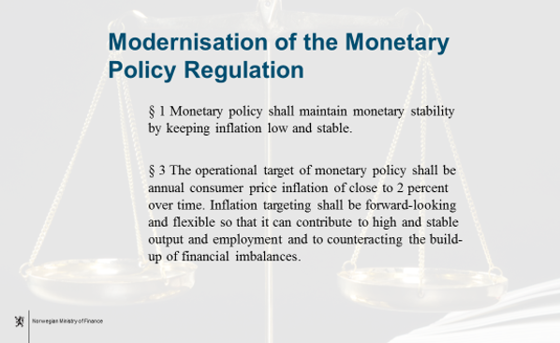
In the recent update of Norges Bank’s monetary policy mandate, which was announced on March 2nd, the Government decided to explicitly include financial stability considerations into the statutory objectives for monetary policy.
Stabilizing inflation around the inflation target remains the primary objective for monetary policy, but we also explicitly stated that monetary policy should be forward-looking and flexible so that it can contribute to high and stable output and employment and counteract the build-up of financial imbalances. It is important to note that the role of financial imbalances is asymmetric: Norges Bank should put a weight on financial stability consideration when risk are assumed to be increasing, but not necessarily loosen policy if risks are assumed to be declining.
This represents a change in the statutory mandate for monetary policy. However, in my view, it is unlikely to alter how the policy rate is set, as it is largely a formalization of how Norges Bank has been conducting monetary policy. The Bank also shares this view, something they have stated clearly in public.
The new monetary policy regulation also lowered the inflation target from 2,5 to 2 percent. When the inflation target was first introduced in 2001, the Norwegian economy was entering a period of large increases in the amount of oil revenues that were being phased into the economy. This was assumed to entail a real appreciation, and the view at the time was that the smoothest way to achieve this was through slightly higher inflation than our trading partners, rather than a strengthening of the krone.
We now believe that the phasing in of oil revenues is close to its peak, and so the argument for aiming for a different inflation target than our trading partners is no longer present. We therefore decided to lower the inflation target to 2 percent. We are of course well aware of the debate about whether inflation targets should be increased, so that real rates can be lowered further when the effective lower bound on nominal rates is reached. There may be merit to this argument, but to my understanding such a move would require coordinated action by the international community in order to prevent disruptive exchange rate movements.
Summing up
Let me sum up.
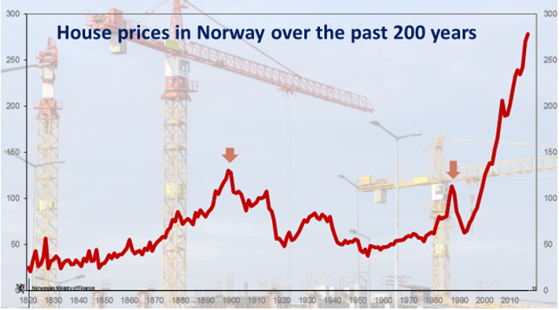
Financial crises come at great costs to society. Following the housing market crash in Oslo in 1899, large fortunes were lost and a number of apartments stood empty for years. It was only in the booming 1980s – 90 years later – that house prices, after adjusting for inflation, were back at their pre-crisis levels. At that time another banking crisis was already brewing. Today, despite a few rough years in the Norwegian economy and a cooling housing market, I still see plenty of cranes when I look up at Oslo’s skyline.
Our broad approach to financial stability has proved useful to mitigate the build-up of risks in the housing market in recent years. Building buffers in our financial system is the best way to make our economies less vulnerable to the consequences of financial disruptions. In an international environment where banks’ activities no longer are limited to domestic markets, and where financial unrest quickly affects multiple countries, we need international solutions. International co-operation on regulation of financial markets is in the interest of all countries. This includes Norway as a small open economy with close ties to the rest of Europe, and the UK as the world’s leading financial center with close ties to the rest of Europe.
The UK has played an important role in developing the European single market for financial services. Norwegian and British views have often been aligned. [We will miss the British voice in the EU.] Independent of Brexit there will be a need for close cooperation and coordination on financial market issues in Europe also in the future.
I am sure the UK will continue its efforts to promote sound and safe financial institutions and work toward a level playing field internationally for the financial sector in the years to come.
Thank you very much for listening!